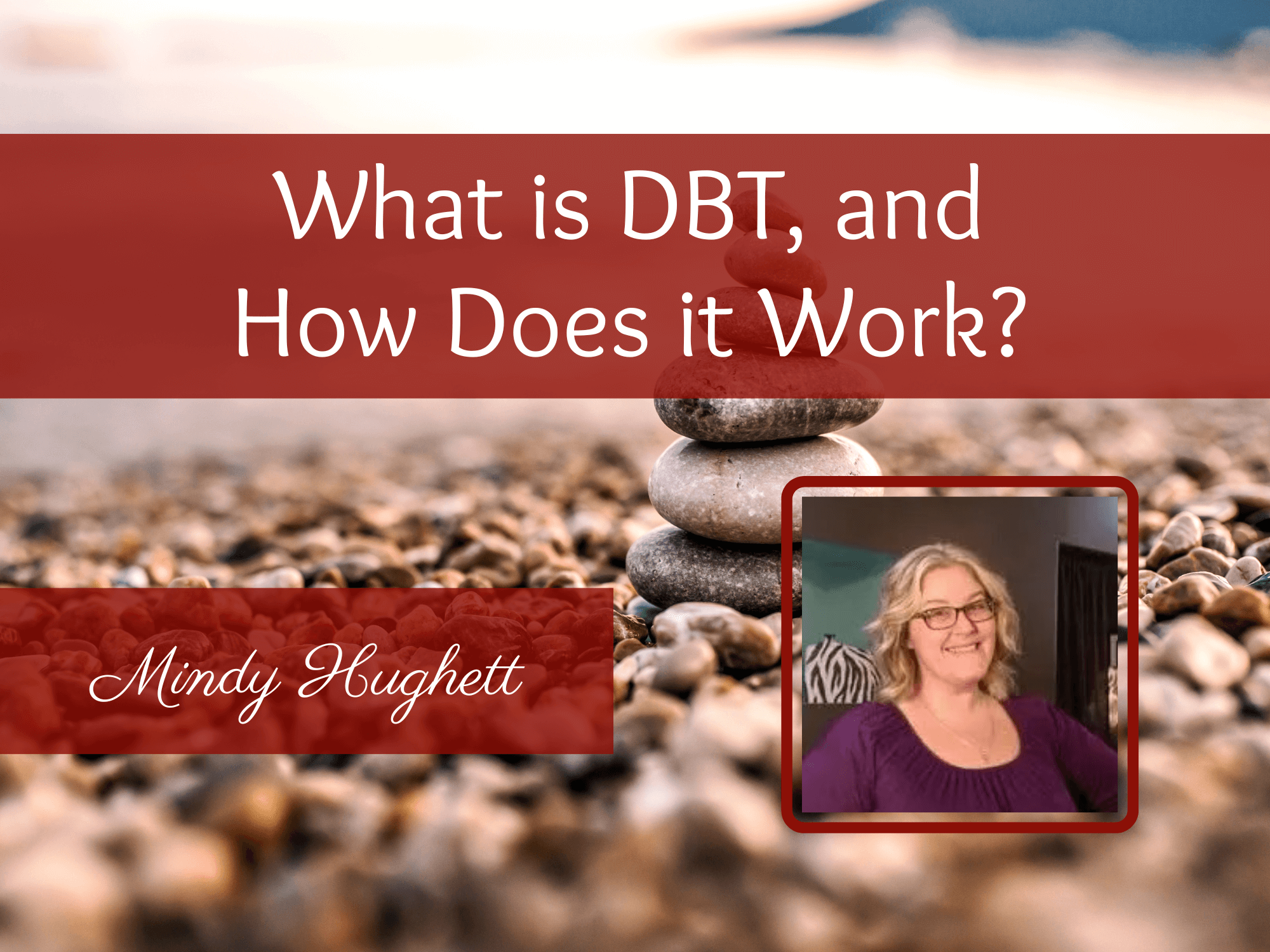There are several therapeutic techniques counselors use to help clients, a few common ones being Cognitive Behavioral Therapy (CBT), hypnotherapy, Eye Movement Desensitization and Reprocessing (EMDR), and interpersonal therapy. Today, we are focusing on Dialectical Behavior Therapy (DBT).
DBT is very similar to CBT but focuses more on regulating emotions, improving mindfulness, and accepting uneasy feelings and thoughts. It can be used to treat conditions such as eating disorders, PTSD, mood disorders, personality disorders, and substance use disorders.
To learn more about DBT, we talked to Mindy Hughett, LCSW, a Kenosis associate. After graduating from her Master’s program and interning at Kenosis, she joined the staff full-time. Mindy completed training with Dr. Lane Peterson, then continued her education with Dr. Julie Brown specifically on DBT. She earned the Skills Coach certification for Skills System, which is a type of DBT used with persons who have cognitive challenges. Mindy has been utilizing DBT with her clients for eight years. In this article, Mindy explains who DBT is for, what DBT sessions are like, and shares a story of a client who had DBT work wonders in her life.
The Ins and Outs of DBT
Mindy explains that DBT “gives you a framework, so you can learn how to manage high-stress situations by utilizing tools and downregulating.” Downregulating is the process of reducing the response to a particular stimulus, typically stress. The goal of DBT is for clients to learn these skills and then utilize them when they experience stressful situations.
DBT is for people who have trouble managing their emotions and stress levels. Many clients who receive DBT have a diagnosis of borderline personality disorder or have experienced trauma. Therapists can also use it with people who have addictions, struggle with downregulation, or have difficulties coping with everyday life.
Mindy comments, “DBT works for the everyday person struggling with the many parts of life in chaos (work, school, relationships, and community.) The multi-component treatment works by creating a plan of management to slow down your external response and create a plan for a healthier response to your environment.” The four primary skills DBT teaches are mindfulness, distress tolerance, emotional regulation, and interpersonal effectiveness. She says, “I utilize interpersonal effectiveness tools with people who have difficulties with relationships and trying to communicate their needs. Then mindfulness is a great skill for everyone to learn, and it looks different for everyone.” DBT is very customizable for each client’s struggles.

DBT vs. CBT
DBT is sometimes confused with CBT, another therapeutic technique that shares several similarities. Both forms of therapy focus on changing a person’s behavior. DBT teaches the dialectic aspect of changing behaviors—in other words, accepting unpleasant situations and coming to terms with the need for change. Learning how to verbally communicate feelings is just as important as changing troubling behaviors. Mindy clarifies, “A lot of times, we talk about all or nothing thinking. DBT teaches [people] to be in the middle, to live in the gray, and to get comfortable with it.”
Cognitive Behavioral Therapy (CBT) teaches clients how to change their cycle of thinking. Negative thoughts can seriously impact our emotions, so CBT focuses on modifying a person’s thought process to a more positive outlook on life. Mindy adds, “CBT works for almost every single person, but it doesn’t work as well for people who can’t downregulate.” When a client struggles with downregulation, DBT becomes the preferred method of therapy.
What happens in DBT therapy?
Sometimes people are nervous about attending therapy. It can be even scarier when you don’t know what to expect.
In the first therapy session, you and the therapist evaluate a biopsychosocial assessment to determine the correct course of treatment. If DBT is the course of treatment for you, the therapist will discuss a manual that could be effective for you to complete as homework outside of the session. At Kenosis, there is currently a skills work group that could be very helpful in combination with individual counseling.
“Normally, at the beginning of a session, we do mindfulness downregulation skills to shake off the world. We check in with the treatment plan for the session and explore what the area of focus is for the session,” explains Mindy. The session continues with figuring out how to use the client’s skills to problem solve and process their feelings about particular situations. The session ends with homework to complete before the next session and another downregulation exercise.

DBT heavily incorporates the personal goals of the client as well. It can help them reach:
- Emotional life goals
- Emotional health goals
- Physical health goals
- Academic goals
- Professional goals
Mindy remembers a client for whom DBT was successful in helping her reach emotional goals: “I have a client that was going in and out of the hospital for inpatient psychiatric treatment. She was so tired of going in and out of the hospital, but she didn’t know any other way to cope with her life circumstances. She saw me twice a week and was dedicated to working on her homework and going to different support groups in the community. She was able to stay out of the hospital and was just a happier woman. She could be a mom to her kids, and she ended up teaching her kids DBT skills. That was their way to relate and cope together. She taught her kids how to downregulate, and her kids stated, ‘we gotta use this skill, mom.’ It was adorable.”
If you can relate to this story, know that healing is possible. Communicating and managing your feelings can be difficult when you don’t have the right tools. Seeing a therapist trained in DBT can give you a compassionate, non-judgmental perspective on your situation. Mindy ends with, “[DBT is] all about validation, acceptance, objective, behavioral change.” There is no shame in recognizing you or a loved one is struggling and reaching out for help.

